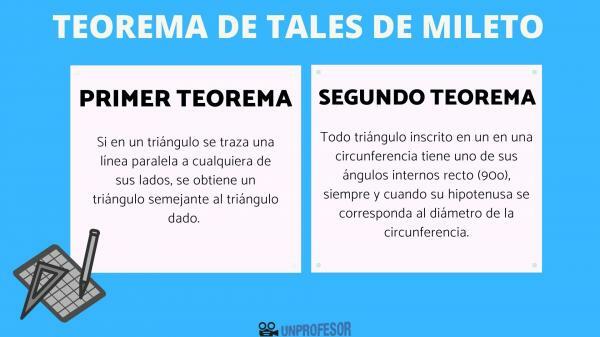Thales of Miletus theorem

In today's lesson we are going to explain to you Thales' Theorem of Miletus (624-546 a. C.) developed by the first philosopher of the West and the founder of philosophy as a rational knowledge that seeks to give a logical explanation of the origin of the universe. But, in addition, Thales also stood out for his contributions to other disciplines such as mathematics or physics, so he was also one of the first mathematicians of the West, a “philosopher of nature ”.
Among his contributions to science stands out his thesis to explain natural phenomena through a scientific method and his famous theorem in the field of geometry. A theorem that is still used today to measure the height of buildings. Keep reading because in this unit of a PROFESSOR we explain what the Thales of Miletus Theorem consists of.
We know little about the life of Thales of Miletus, except that he was born, lived and died in the commercial city of Miletus (Asia Minor-Turkey), who was a descendant of Phoenicians, who was the founder of the
Miletus school and that throughout his life he was in contact with other cultures, sharing and acquiring new knowledge. Hence, the rise of mathematical knowledge of him.Precisely, Thales of Miletus' interest in mathematics developed through his commercial contact with Egypt and Mesopotamia. Places where, during the 6th century BC. C., there was already a fairly advanced knowledge of mathematics and astronomy. In fact, it is quite possible that most of his knowledge was acquired in Egypt from the hands of the priests, which, were the possessors of the scientific and philosophical knowledge of the country of the Nile.
In this way, what Thales did was organize and transfer all the knowledge acquired to Greece and, later, develop it through his school and his disciples as Anaximander (610-545 BC. C.) or Anaximenes (585-528 a. C.). However, as far as geometry is concerned it will not be until the arrival of Pythagoras, when Thales' work is resumed.
Finally, it should be noted that the mathematical work of Thales has come to us through The Euclid's elements(IV book, 300 a. C.). Work in which all the mathematical knowledge of antiquity is compiled.
The theorem of Thales of Miletus is made up of two theories known as the first and second theorem. Which are based on two premises:
- Similar triangles are those that do have the same shape, their angles are equal and their sides are proportional, but different in size.
- Parallel lines are always the same distance and never intersect.
Having these two ideas clear, it will be easier for us to understand what Thales tells us is his two theorems:
- First theorem: If a line is drawn parallel to any of its sides in a triangle, a triangle similar to the given triangle is obtained. That is, if we have a triangle formed by A, B and C (for each of its sides) and we draw on it two parallel lines, we will obtain a similar triangle formed by A´, B´ and C´ (for each of its sides). Thus, the triangle obtained will be of the same shape, with equal angles and proportional sides, but smaller than the first triangle (A, B and C).
- Second theorem: Every triangle inscribed in a in a circle has one of its right internal angles (90or), as long as its hypotenuse corresponds to the diameter of the circumference.
Likewise, Thales' contributions to the field of geometry not only remained in the previously explained theorem, but also he correctly stated that:
- If any two lines are intersected by several parallel lines, the segments determined on one of the lines are proportional to the corresponding segments on the other.
- Every circle is divided into two equal parts by its diameter.
- The angles opposite the vertex that are formed when two equal lines intersect are equal.
- The base angles of every isosceles triangle are equal.

Taking into account the extensive knowledge of geometry Thales had, he was able to solve two problems that until now had not been solved:
Measure the pyramid of Cheops
According Herodotus and Diogenes Laercio, Thales was able to find the height of the pyramid of Cheops from the length of his shadow. For this he put his first theorem into practice and what he did was stand right in front of the pyramid and wait for his shadow to be equal to the shadow of the pyramid. At which point your head and the top are at an angle of 25or.
Find out how far away the enemy ships were
It is also said that when the city of Miletus was being besieged by enemies, the soldiers came to Thales to ask him how far the ships were from the coast so that he could calculate when to launch the projectiles from the catapult. Thus, what the mathematician did was go to a cliff with a stick, in such a way that he placed the stick horizontally (parallel to the visual of the ship) and made the height of the cliff coincide with the length of the pole, thus obtaining the distance correct.



